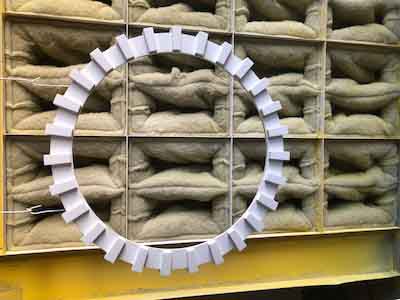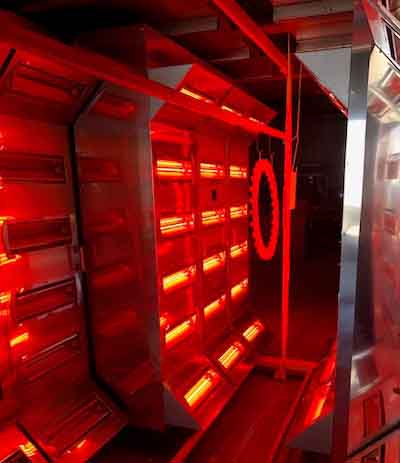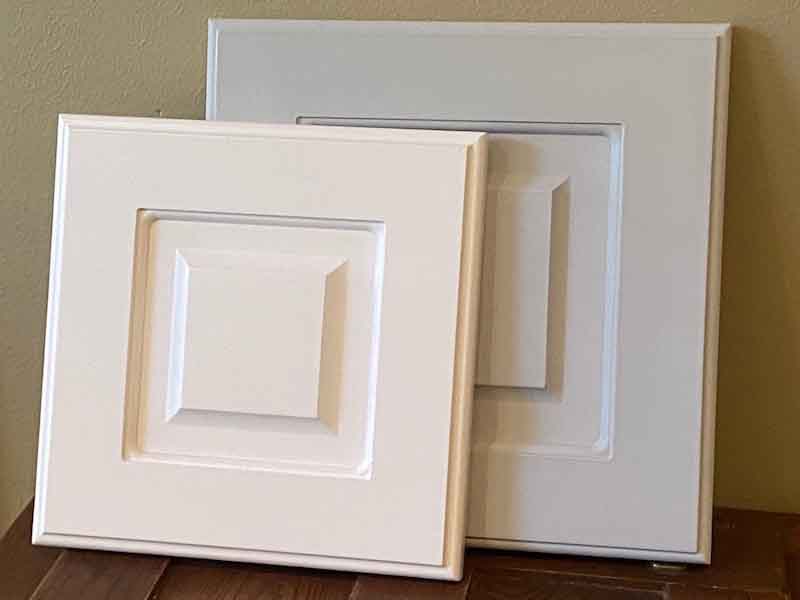When Chris Reding became IFS Coatings’ Global Director of Alternative Substrates at the close of 2018, he made it his mission to deliver the solutions needed to accelerate powder coating beyond metal.
 Chris RedingIn the few years before Reding joined IFS, manufacturers of powder coatings, application equipment, and oven suppliers had each introduced innovations aimed at advancing the use of powder coating beyond metal.
Chris RedingIn the few years before Reding joined IFS, manufacturers of powder coatings, application equipment, and oven suppliers had each introduced innovations aimed at advancing the use of powder coating beyond metal.
“The challenge I saw was putting it all together,” he says.
From the start, IFS set out to offer the most complete portfolio of powder coatings designed for wood and MDF, a challenge taken up by Derick Forcha, who joined IFS as Senior Research and Development Scientist in 2019.
Flow, Flex, and Transfer
Forcha was tasked to master peroxide cure chemistry which — in the few years since its introduction — established a promising foothold in the European market. IFS eventually branded the resulting product line as PureClad FFT to highlight the properties that make the technology so special: flow as in smoothness, flex for its post-cure flexibility, and the transfer which results through incorporation of IFS technology that enhances the powder’s ability to accept electrostatic charging.
Reding says the emphasis on flexibility was extremely important.
“Wood doesn’t behave after it is coated,” he says. “Wood will shrink and swell as it absorbs and releases moisture over time, and the coatings has a tendency to crack if they aren’t sufficiently flexible to accommodate this behavior. The post-cure flexibility of FFT is exceptional – nothing comes close.”
 Derick ForchaApart from developing the FFT technology, Forcha was also tasked to optimize traditional catalyzed chemistries — branded PureClad W — with the goal to equip IFS to supply both the new market potential associated with the promise of FFT, as well as the handful of existing contract coaters offering powder coating for MDF.
Derick ForchaApart from developing the FFT technology, Forcha was also tasked to optimize traditional catalyzed chemistries — branded PureClad W — with the goal to equip IFS to supply both the new market potential associated with the promise of FFT, as well as the handful of existing contract coaters offering powder coating for MDF.
By the beginning of 2020, products based on both FFT and W chemistries were ready for commercial launch.
“I anticipated that with traditional catalyzed chemistry,” Reding says. “But having FFT — which is entirely different, both to formulate and to manufacture — so quickly wasn’t something that I expected.”
But that wasn’t the only surprise that Forcha and his team had in store.
“People like me, who have decades of experience in and around powder coating, tend to develop an inventory of things that we know can never be done,” says Reding says, who shortly after meeting Forcha mentioned one of those impossible things as part of a wish list: an ultra-low cure, UV durable powder coating, with good flow, and post-cure flexibility.
To Reding’s complete surprise, the team delivered PureClad X technology. Based on accelerated testing, IFS estimates that in a single opaque coating, X will deliver better than three years gloss retention in South Florida exposure. Based on similar chemistries used in outdoor powders for metal, it has 2-3 times that with the addition of a clear topcoat.
Unique Collaboration with Oven, Application Equipment Manufacturers
 Reding says they understood that chemistry was only one part of the puzzle. To deliver complete solutions, they needed help, so Reding set out to form collaborative relationships with both oven manufacturers and powder application equipment suppliers to complete the enigma.
Reding says they understood that chemistry was only one part of the puzzle. To deliver complete solutions, they needed help, so Reding set out to form collaborative relationships with both oven manufacturers and powder application equipment suppliers to complete the enigma.
“The potential for powder coating alternative substrates is so much bigger than in the market space we are in right now,” Reding says. “I stopped counting when I got to 10 times bigger.”
Given that potential, several allies in the equipment community – who were an indispensable element to make it all happen – were onboard from the start.
Historically, powder coating alternative substrates has been a challenging proposition. While the fundamentals, electrostatic application, and thermoset curing are largely the same, the differences from metal coating are substantial.
“Wood is temperature-sensitive, so once you sort out how to cure powder at temperatures that won’t cause damage, you have to design powders that will deliver required aesthetic and performance properties,” says Reding, who adds that beyond cure the electrostatics are more challenging, and precise control of film thickness is essential for good aesthetic results, especially in the case of clear coats and some textures.
“We’ve crossed those hurdles on the formulary side, but chemistry alone doesn’t make for a complete solution,” Reding says.
Utilizing Moisture Control
 Because wood is not conductive, the moisture contained in wood is used for electrostatic grounding.
Because wood is not conductive, the moisture contained in wood is used for electrostatic grounding.
“The moisture content of wood — while necessary for grounding — presents a challenge,” Reding says. “We needed to know how to provide sufficient heat to cure the powder without causing defects associated with outgassing of water vapor during the cure process.”
The answer to that riddle came from Mike Chapman, whose friendship with Reding began around 2013 through Chapman’s company, Vulcan Catalytic Systems, a pioneer in infrared (IR) cure technology.
Like other organic materials, powder coating absorbs IR particularly well in the 4-5 micron wavelength range. With emitters designed to work in that range, Reding and Chapman realized they now had a mechanism to cure powder without relying on heating the wood to the temperatures required for cure.
“While IFS can take a lot of the credit for developing powders that deliver required appearance and performance properties at only 260°F-275°F, the short duration of the cure process — usually 4-5 minutes — would not be possible without IR,” Reding says.
For electrostatic solutions, Reding reached out to Gema, which he views as a premier solutions provider, particularly in the field of powder coating alternative substrates.
“To begin with, I should mention Gema’s ‘dense phase’ technology, which is very relevant to powder coating wood. This technology provides for both precision metering and long term system reliability, as well as to reduce impact fusion which can occur with low glass transition temperature (Tg) powders, commonly used in low-cure systems. Beyond that, Gema’s help on the electrostatic side of the coin has been invaluable. Their dynamic counter electrode technology (whereby an electrostatic field is used to prevent powder from building where you don’t want it to build) is an amazing breakthrough to eliminate wrap and to achieve precision control of film thickness.”
Growth in Europe
 The hope now is that manufacturers will embrace the use of powder coating on their wood or MDF parts. In Europe, the practice is growing more each year. Kempa, a high-end kitchen cabinet manufacturer based in Belgium, switched to powder coating in 2016 for faster processing of its components and for a reduction in costs.
The hope now is that manufacturers will embrace the use of powder coating on their wood or MDF parts. In Europe, the practice is growing more each year. Kempa, a high-end kitchen cabinet manufacturer based in Belgium, switched to powder coating in 2016 for faster processing of its components and for a reduction in costs.
Working with Wagner and its new Field Controller setting charge distribution system, Kempa applied coatings based on DSM’s “Ultra” technology and saw a 10x increase in production and was sold on the process.
“Obviously, it depends on the type of substrate and the number of layers,” says Paul Maeyninckx, Kempa’s owner. “But it is possible to use just three minutes of oven time with powder, rather than half an hour with paint.”
Filip Laureyssen, Kempa’s Customer Care Manager, says its customers are specialist kitchen builders, and for several years they have occasionally asked if they did powder coatings.
“But in the last three years, there seems to have been a sudden increase of interest, so naturally, we decided to look into the possibilities,” Laureyssen says. “We also believed that the technology had reached the level of sophistication where we wanted to use it.”
Architects Seeking Green Alternatives
 The kitchen building community in Europe was hearing more about the time and cost savings over liquid paints and also about the higher durability advantages. Laureyssen says they also found that architects were particularly interested in the product’s very low carbon footprint.
The kitchen building community in Europe was hearing more about the time and cost savings over liquid paints and also about the higher durability advantages. Laureyssen says they also found that architects were particularly interested in the product’s very low carbon footprint.
“This characteristic helps architects achieve more ‘green’ credentials in their proposed tenders for local and national government new builds,” he says.
In 2018, a leader in project furniture design, Vepa, began using powder coating as a sustainable alternative to solvent-based liquid coating technology for heat-sensitive substrates. Initially, Vepa produced one furniture product line with powder coating but quickly launched a second by the end of that year.
“Powder coating technology offers several important advantages to furniture manufacturers,” says Gertjan de Kam, Vepa’s Design and Development Manager. “Above all, powder coating enables greater design freedom since it can be applied even on unusual shapes, edges, hollows, and contours, allowing imaginative new substrate designs and semi-assemblies that could not easily be finished with liquid coatings.”
Hope for Growth in the U.S.
Reding is confident that more U.S. powder coaters will begin to embrace the process as early adopters begin to see results. These include a line in Idaho experiencing steady growth in both MDF and fiberglass applications, as well as a new, high capacity operation in Northern Texas that he is currently working with to launch priming services for cabinet manufacturers.
Eventually, he predicts powder coating on wood will be the norm instead of the exception.
“When I was a young guy, I had a friend who tried to sell me on the idea of going into the bottled water business,” Reding says. “I kept thinking, ‘who is going to buy water?’ and I let the chance pass me by, although I hear that bottled water actually did okay and he’s doing well.”
He predicts that powder coating wood — given the advances that have happened in just the last few years — as another massive opportunity.
“And unlike bottled water, I’m not going to miss out this time around,” Reding says.
Visit http://ifscoatings.com/



































